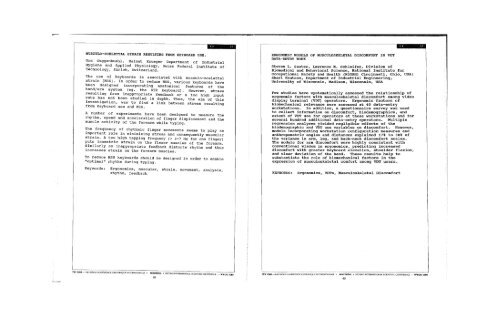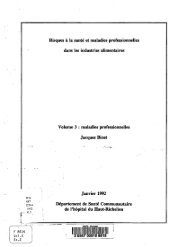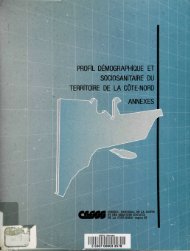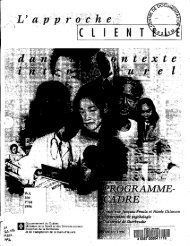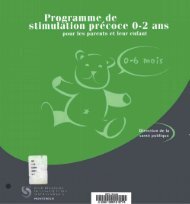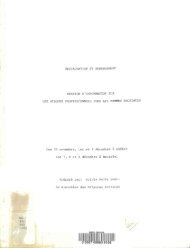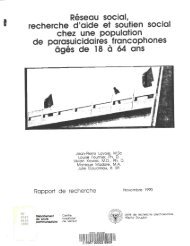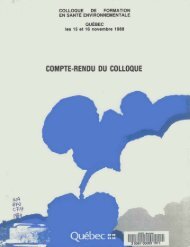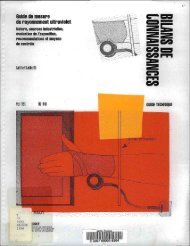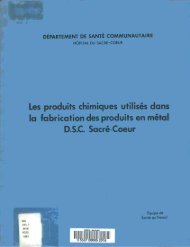MUSCULO-SCELETTAL STRAIN RESULTING FROM KEYBOARD USE.Urs Guggenbuehl, Helmut Krueger Department of IndustrialHygiene and Applied Physiology, Swiss Fe<strong>de</strong>ral Institute ofTechnology, Zurich, Switzerland.The use of keyboards is associated <strong>with</strong> musculo-sce<strong>le</strong>ttalstrain (MSS). In or<strong>de</strong>r to reduce MSS, various keyboards havebeen <strong>de</strong>signed incorporating anatomical features of thehand/arm system (eg. the STR keyboard). However, stressresulting from inappropriate feedback or a too high inputrate has not been studied in <strong>de</strong>pth. Thus, the aim of thisinvestigation, was to find a link between stress resultingfrom keyboard use and MSS.A number of experiments have been <strong>de</strong>signed to measure therhythm, speed and acce<strong>le</strong>ration of finger displacement and themusc<strong>le</strong> activity of the forearm whi<strong>le</strong> typing.The frequency of rhythmic finger movements seems to play animportant ro<strong>le</strong> in minimizing stress and consequently muscularstrain. A too high tapping frequncy (> 6-7 Hz for one finger)puts isometric strain on the f<strong>le</strong>xor musc<strong>le</strong>s of the forearm.Similarly an inappropriate feedback distorts rhythm and thusincreases strain on the forearm musc<strong>le</strong>s.To reduce MSS keyboards should be <strong>de</strong>signed in or<strong>de</strong>r to enab<strong>le</strong>"optimal" rhythm during typing.ERGONOMIC MODELS OF MUSCULOSKELETAL DISCOMFORT IN VDTDATA-ENTRY WORKSteven L. Sauter, Lawrence M. Sch<strong>le</strong>ifer, Division ofBiomedical and Behavioral Science, National Institute forOccupational Safety and Health (NIOSH) Cincinnati, Ohio, USA;Sheri Knutson, Department of Industrial Engineering,University of Wisconsin, Madison, Wisconsin, USAFew studies have systematically assessed the relationship ofergonomie factors <strong>with</strong> musculoske<strong>le</strong>tal discomfort among vi<strong>de</strong>o<strong>display</strong> terminal (VDT) operators. Ergonomie factors ofbiomechanical re<strong>le</strong>vance were assessed at 40 data-entry<strong>work</strong>stations. In addition, a questionnaire survey was usedto col<strong>le</strong>ct information on discomfort, bio<strong>de</strong>mographics, an<strong>de</strong>xtent of VDT use for operators at these <strong>work</strong>stations and forseveral hundred additional data-entry operators. Multip<strong>le</strong>regression analyses yiel<strong>de</strong>d negligib<strong>le</strong> effects of thebio<strong>de</strong>mographic and VDT use variab<strong>le</strong>s on discomfort. However,mo<strong>de</strong>ls incorporating <strong>work</strong>station configuration measures andanthropometric ang<strong>le</strong>s and distances explained 17% to 38% ofthe variance in arm, <strong>le</strong>g, and back-neck discomfort sca<strong>le</strong>s.The mo<strong>de</strong>ls for arm discomfort were highly consistent <strong>with</strong>conventional wisdom in ergonomics, predicting increaseddiscomfort <strong>with</strong> greater keyboard e<strong>le</strong>vation, shoul<strong>de</strong>r f<strong>le</strong>xion,and ulnar <strong>de</strong>viation of the hand. These results help tosubstantiate the ro<strong>le</strong> of biomechanical factors in theexpression of musculoske<strong>le</strong>tal comfort among VDT users.Keywords:Ergonomics, muscular, strain, movement, analysis,rhythm, feedbackKEYWORDS:Ergonomics, VDTs, Musculoske<strong>le</strong>tal DiscomfortTEV ,989 - DEUXIÈME CONFÉRENCE SCIENHFIQUE IN TERNATIONALE • MONTRÉAL . SECOND INTERNATIONAL S ^ ^ C O ^ T T Z ^ ^48TEV 1989 — DEUXIÈME CONFÉRENCE SCIENTIFIQUE INTERNA TIONALE • MONTRÉAL • SECOND INTERNATIONAL SCIENTIFIC CONFERENCE — WWDU 198949
6TRAIN ANALYSIS AT WORD PROCESSING WORKPLACE CAUSINGMUSCULOSKELETAL DISORDERSKurt Landau, Claudia LeonhardtUniversity of Hohenheim, West GermanyGoal of this study was to shape a <strong>work</strong>ing-posture at the computerterminal <strong>with</strong> EMG-Biofeedback which would allow for op?ïmaïrelaxation of the upper parts of the trapecius musc<strong>le</strong>. This was tobe achieved by activating the lower parts of the trapecius musc<strong>le</strong>lax t n f th JL «PPer parts. Furthermore EMG-Biof eedback wasapplied whi<strong>le</strong> the subject is <strong>work</strong>ing to <strong>de</strong>tect and reduce^ens , ing of the musc<strong>le</strong>s during phases of informationaland emotional stress.Stress at three groups of VDU <strong>work</strong>places of an automobi<strong>le</strong>manufacturer (A: Data entry, B: Matchco<strong>de</strong>/Sa<strong>le</strong>s, ^Contractacceptance) was assessed using the Ergonomie Job DescriptionQuestionnaire (Landau, Rohmert, 1981) and evaluated for any longterm performance limits being excee<strong>de</strong>d, The stress profi<strong>le</strong>s showedthat, <strong>with</strong> data entry only, bott<strong>le</strong>necks existed in the area ofvisual and proprioreceptive information .reception as well as inthe_ motor area, whereas they were found in the comp<strong>le</strong>xity of<strong>de</strong>cision-making in the other two types of <strong>work</strong>places. With all<strong>work</strong>places, stress caused by static postural <strong>work</strong> received ratingsabove the average. The <strong>work</strong>ing places were further analysed usinga <strong>de</strong>sign checklist and corrected to achieve optimal ergonomieconditions The impact of different body distances and <strong>work</strong>ingheights of the keyboards on musc<strong>le</strong> strain was assessed.On a voluntary basis 29 (14 fema<strong>le</strong>, 15 ma<strong>le</strong>; age range 22-48) VDU<strong>work</strong>ersof an automobi<strong>le</strong>-company participated in the biofeedback"training sessions spaced over 6 weeks.The training was done at each individual s own <strong>work</strong>ing place, in awi<strong>de</strong>-spaced multip<strong>le</strong> office facility <strong>with</strong> movab<strong>le</strong> shielding wallsto allow for some privacy and reduce disturbances.The biofeedback-training-program was highly successful as becomesevi<strong>de</strong>nt by the significant tension reduction in the upper parts of-the trapecius musc<strong>le</strong> in all three groups comparing 1st and 8thsession whi<strong>le</strong> <strong>work</strong>ing. In many cases an increase in the activityof the lower parts of the trapecius musc<strong>le</strong> through feedbackbrought about by itself a <strong>de</strong>crease in the activity of the upperparts ot the trapecius musc<strong>le</strong> reduced tension even further Oversessions the baseline value of the lower trapecius musc<strong>le</strong>increased and the subjects reported that it became easier for them-to sit m the <strong>de</strong>sired posture.In the course of the biofeedback training, the subjective physicalcomplaints <strong>de</strong>creased from an initial 2.46 on a five-gra<strong>de</strong> sca<strong>le</strong>r^niff^T 1 ?? r * tin «" to O" 5 , 4 ^ ^e end of the training. This? ffect could be observed six weeks after the endof the training.VISUAL SCREENING TESTS, EYE SYMPTOMS AND LENGTH OF SERVICE IN VDUOPERATORS.Th. L<strong>à</strong>ubli, H. Nibel, U. Schwaninger, C. Thomas, H. Krueger, Department of IndustrialHygiene and Applied Physiology, Swiss Fe<strong>de</strong>ral Institute of Technology, CH-8092 Zurich,SwitzerlandThe aim of the study was to investigate possib<strong>le</strong> long-term effects on vision by <strong>work</strong> <strong>with</strong>VDUs. Nearly 3000 questionnaires were col<strong>le</strong>cted in five German companies, that wereusing VDUs for many years and willing to collaborate. In one company, results of visualscreening tests were availab<strong>le</strong> that inclu<strong>de</strong>d examinations between 1970 and 1987. Asamp<strong>le</strong> of 800 tests (all cases <strong>with</strong> names beginning <strong>with</strong> a until fe) was analyzed.A modified version of a previously <strong>de</strong>scribed questionnaire (Lâubli 87, Zeier 87) inclu<strong>de</strong>dquestions on postural discomfort, headache and eye symptoms (<strong>de</strong>pen<strong>de</strong>nt variab<strong>le</strong>s).In<strong>de</strong>pen<strong>de</strong>nt variab<strong>le</strong>s were age, sex, <strong>le</strong>ngth of VDU-use (years), amount of VDU-use(fractions of total <strong>work</strong>ing time) and type of <strong>work</strong>. The response rate was 39%.Visual screening tests were done using two different makes ("Ro<strong>de</strong>nstock R7" until 1980and "Ro<strong>de</strong>nstock R12" since 1981). The following tests were recor<strong>de</strong>d: binocular andmonocular visual acuity in far and near vision, stereo vision, phorie (far and near), colourvision. Subjects using glasses or contact <strong>le</strong>nses were tested <strong>with</strong> their corrections.Further information inclu<strong>de</strong>d age, sex, date of examination, date of employment, medicaldiagnosis and medical notes on reported symptoms. At each company subjects werevery concerned about the confi<strong>de</strong>ntiality of the col<strong>le</strong>cted data even though the surveywas anonymous. Linking of records and questionnaire mostly was not ma<strong>de</strong> possib<strong>le</strong>.The amount of <strong>work</strong> at VDUs, <strong>le</strong>ngth of service and type of <strong>work</strong> were strongly related tosex and age. Women were more likely to be involved <strong>with</strong> data-entry and other repetitivetasks.Eye symptoms increased <strong>with</strong> the amount of <strong>work</strong> at VDUs. There was no relationship<strong>with</strong> <strong>le</strong>ngth of service. Women more often suffered from eye strain than men. The latterdifference may be explained by the more repetitive and therefore more strenous<strong>work</strong>load in fema<strong>le</strong> <strong>work</strong>ers. The correlation was not significant between age and eyesymptoms. These direct relationships were verified by stratified analyses.Visual screening tests varied significantly <strong>with</strong> year of examination. Thereforeanalyses of long-term effects was inconclusive.Based on univariate analyses significant relationships <strong>with</strong> low visual acuity were asfollows: increased age, use of glasses, more visual complaints.Keywords: visual screening tests, visual discomfort, epi<strong>de</strong>miologyanTEV 12 1989 — DEUXIÈME CONFÉRENCE SCIENTIFIQUE.INTERNATIONALE • MONTRÉAL • SECOND INTERNATIONAL SCIENTIFIC CONFERENCE — WWDU 1989TEV 1989 — DEUXIÈME CONFÉRENCE SCIENTIFIQUE INTERNATIONALE • MONTRÉAL • SECOND INTERNATIONAL SCIENTIFIC CONFERENCE — "WWDU 198913


